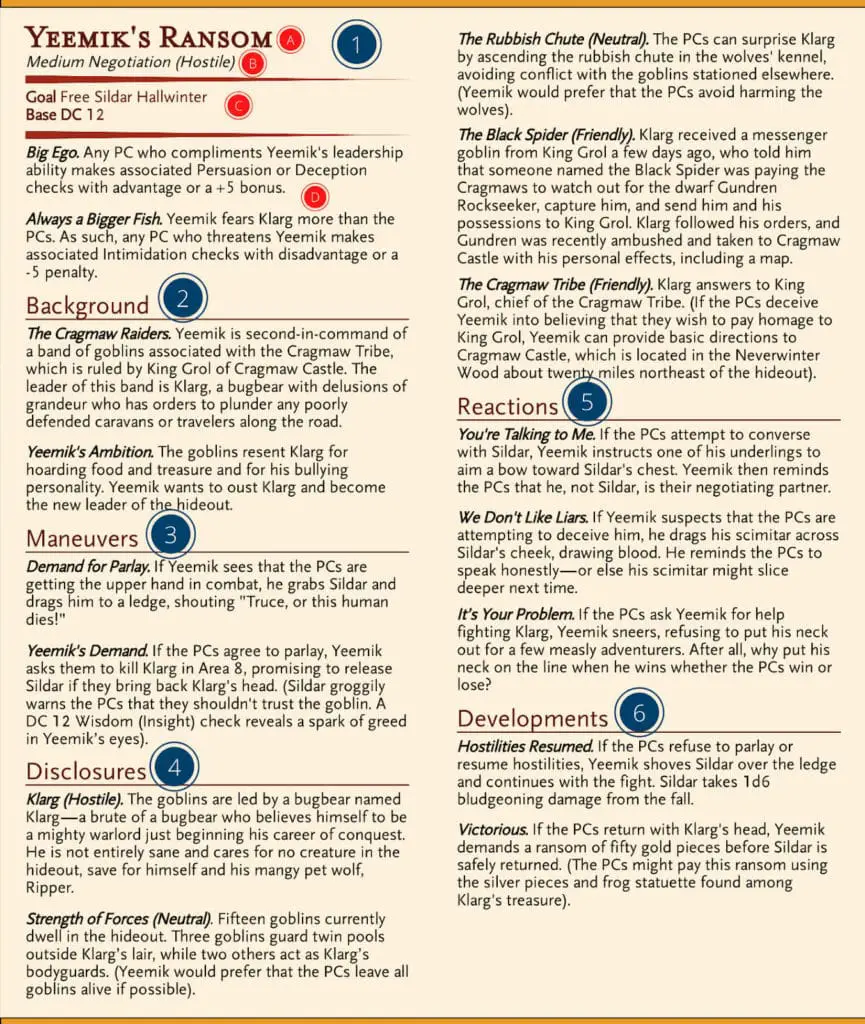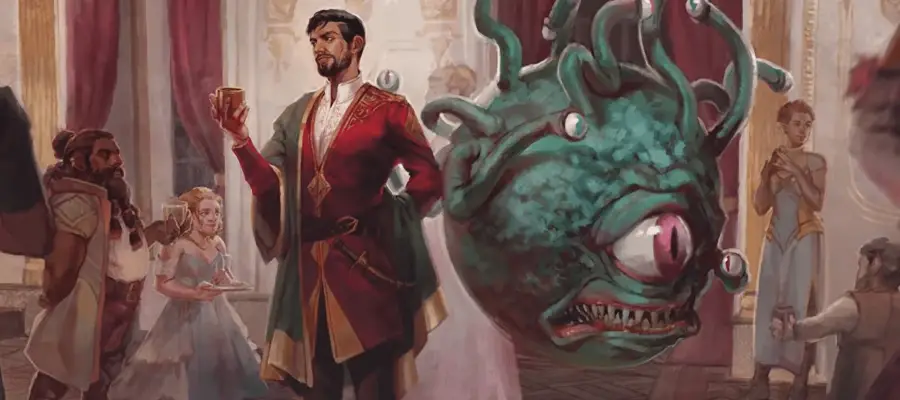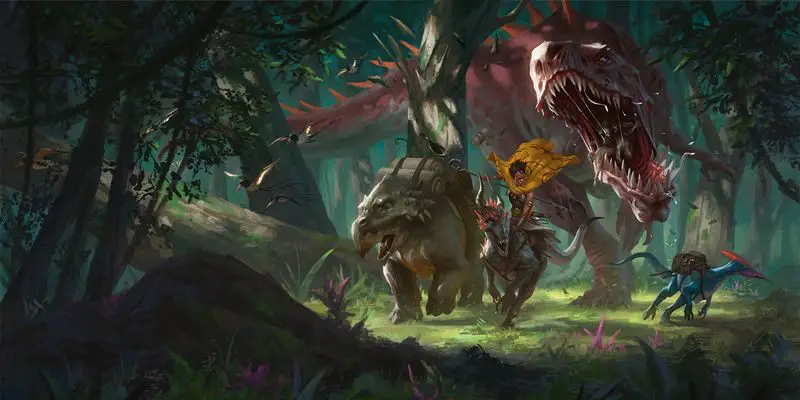Featured image credit WotC @ Candlekeep Mysteries.
Disclaimer: This article contains affiliate links that add gold to our coffers.
Introduction
Coins slip through the nobleman’s fingers, gold glittering as his voice paints honeyed promises.
The great archmage watches you closely, fingers curled around her wand as she listens to your plea.
The vampire lord sits back in his throne, sipping blood-red wine and awaiting your counter-offer.
Fantasy diplomacy often brings high stakes, and Dungeons & Dragons is no different. Whether players are bargaining with a pirate, negotiating a peace treaty, or entering a secret society, 5e social encounters are a cornerstone of the gaming experience—but one that many DMs can find challenging to run.
The Challenges of Conversation
With the advent of 5th edition and character-centric shows like Critical Role, many players come to the table expecting narratives driven by rich, complex characters. Yet embodying those characters can be challenging, especially when a single social encounter might feature intrigue, foreshadowing, and unique personalities—all across the backdrop of a much bigger picture.
DMs running social encounters must often rely on paragraphs of bullet-pointed notes, creating a loop of forgetfulness, cross-referencing, and clumsy adjudication that can leave any DM frustrated. By contrast, while combat encounters also include many moving parts, the combat statblock helps organize our ability to operate enemies in combat, streamlining our efforts and reducing the mental load. How might we do the same for social encounters in D&D 5e?
Social Encounter Statblocks
Let’s take a look at an example 5e social encounter statblock, curated from Chapter 1 (“Goblin Arrows”) of The Lost Mine of Phandelver and prepared in Homebrewery:

1. Details
A. Title
All good encounters deserve a name. Here, this social encounter’s Title is “Yeemik’s Ransom,” reflecting the key NPC’s name and goal.
B. Typeline
The Typeline includes three different aspects:
- Difficulty: Depending on the risk of failure and the consequences of “defeat,” an encounter might be Easy, Medium, or Hard. (See “Attributes” below for more details on difficulty). Here, this social encounter has a Medium difficulty, reflecting the relative challenge it should pose to a party of 1st-level characters.
- Type: An encounter’s “type” can guide your thought process as you prepare and run a scenario. For example, an encounter might be an Introduction, a Negotiation, or a Discussion. Here, Yeemik’s efforts to bargain for Sildar’s release suggests a Negotiation type is appropriate.
- Predisposition: An NPC might begin an encounter Friendly, Neutral, or Hostile to the PCs. Over the course of an encounter, the PCs can befriend or alienate the NPCs they speak with, changing how the encounter unfolds. (See “Disclosures” below for more information on NPC dispositions). Here, Yeemik’s negotiations emerge immediately from combat, signalling a clear Hostile disposition to the PCs.
C. Attributes
The Attributes tell us the PCs’ goal in the encounter, and (2) the Base DC for any social checks they might attempt. The Base DC can be calculated as follows:
| Difficulty | Base DC |
|---|---|
| Easy | 10 |
| Medium | 10 + PCs’ Average Proficiency Bonus |
| Hard | 10 + (2 x PCs’ Average Proficiency Bonus) |
Here, because the PCs are 1st-level characters, the Base DC for any social checks in this encounter is 10 + 2 = 12.
D. Features
The encounter’s Features describe the “battlefield” of the encounter, including character traits, current events, and other topics that the PCs can invoke to gain or lose the NPC’s favor. Invoking these features might grant a bonus or penalty to a PC’s social check.
Here, the key features include Yeemik’s ego (which the PCs can use to manipulate him) and Yeemik’s fear of Klarg (which prevents the PCs from easily intimidating him).
2. Background
The Background includes the necessary context for running the encounter, such as an NPC’s hidden agenda, intimate secrets, or personality; or current events or relevant circumstances.
Here, background details include Yeemik’s association with the Cragmaw Tribe and Yeemik’s ambitions.
3. Maneuvers
A Maneuver is a conversational tactic that an NPC might use to “soften up” the PCs, direct the conversation toward a specific topic, or otherwise coax the PCs to their point of view.
Here, Yeemik has a “starting” maneuver that kicks off the social encounter by threatening Sildar’s life, and a second maneuver demanding Klarg’s death once he feels confident that the PCs are willing to parlay.
4. Disclosures
A Disclosure is a piece of information that the NPC might share with the PCs under certain circumstances, including:
- Information that the NPC wants the PCs to know,
- Information that the PCs want to uncover, or
- Information that the DM wants the PCs to learn
An NPC must have a sufficiently cordial disposition toward the PCs to share any given disclosure. For example, an NPC who feels Hostile to the PCs will fail to mention a disclosure that requires a Neutral disposition or higher.
Here, Yeemik has several disclosures that vary with his disposition toward the PCs. Unless negotiations break down entirely, he will always share information regarding Klarg. If the PCs make efforts to deal honestly and cordially, a Neutral Yeemik may advise the PCs on the best way to reach Klarg. Finally, while Yeemik is unlikely to become Friendly, a party that thoroughly flatters his ego or influences his mind with magic may be able to glean useful information regarding the PCs’ ultimate goals.
5. Reactions
A Reaction is an NPC’s gut response to a probable challenging circumstance, such as a direct question or critique. For example, an NPC may attempt to justify their position, explain their reasoning, mislead or manipulate the PCs, or deflect to a different subject.
Here, a party is particularly likely to throw a wrench into negotiations by speaking with Sildar over Yeemik or attempting to deceive the goblins. Accordingly, Yeemik has two reactions prepared as-needed.
6. Developments
A Development is a fundamental shift in an encounter’s dynamics, such as a misstep that permanently shifts the NPC’s disposition to Hostile, a formal request for the PCs’ services, or a transition to a new encounter (e.g., combat).
Here, the two developments reflect the two most likely outcomes of negotiation: the PCs’ refusal to parlay and the PCs’ successful return to Yeemik’s cave.
In Conclusion
No DM can—or should—try to prepare for every eventuality. An overstuffed statblock can overwhelm even a veteran DM. But a well-balanced social encounter statblock can help offload some of the mental burden, providing flexibility and reliability.
The preparation process can also be a helpful means of getting inside an NPC’s head. What do they want? Who are they like? What do they know? How do they act and react to others? These questions will guide your roleplay as you run social scenarios, making these encounters deeper, richer, and more rewarding for you and your players.
About the Author: DragnaCarta is a guest writer for FlutesLoot.com and a veteran DM with 12+ years of experience. He is the author of the popular “Curse of Strahd: Reloaded” campaign guide and the Dungeon Master and director for the Curse of Strahd livestream “Twice Bitten.” You can get his personal RPG mentoring plus early access to projects by joining his Patreon.
Cast Message in the comments section below to ask DragnaCarta about skill challenges. You can find other articles by DragnaCarta on FlutesLoot.com:





Pingback: The Alexandrian » Advanced NPC Roleplaying Templates
That’s a superb idea!
I thought the same! I’m glad DragnaCarta chose to write about it.